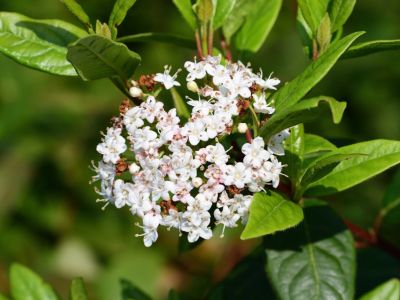What is Viburnum?
Viburnums are a group of large-flowering shrubs, with some varieties reaching up to 20 feet (6 m.). There are both evergreen and deciduous viburnum shrubs. Many have either white or pink blooms in early spring. Also commonly referred to as cranberry bush, viburnums are often used as ornamental fixtures in the home landscape. They are used in shrub borders or as hedges and screening. The larger varieties of viburnum shrub also make excellent focal points as specimen plantings.
Types of Viburnum Shrubs
There are several different types of viburnums. One of the more well-known species is the old-fashioned Snowball viburnum (V. opulus) with beautiful, white, snowball-shaped blooms. Notable viburnum types that are popular for their intoxicating fragrance include the Asian varieties, Cayuga and Burkwood. There are also viburnum shrubs that are commonly grown for their fall foliage or berries. Among the best foliage shrubs are Arrowwood and Linden arrowwood, both producing attractive purplish red leaves. The Tea viburnum is a deciduous species with blue-green foliage. Alleghany viburnum is dark green but occasionally turns purple in fall, remaining throughout winter. Types of viburnums with interesting berry color include those that change as they ripen from green to pink, yellow, or red to blue or black. For instance, Wayfaring tree and Blackhaw viburnums turn from red to black.
Planting Viburnum Flowering Shrub
When planting viburnum shrubs, pay attention to the individual needs of the particular species. Most viburnums prefer full sun but many will also tolerate partial shade. While not particularly picky about their growing conditions, they generally prefer fertile, well-draining soil. Planting viburnum takes place in spring or fall. Dig a hole as deep as the root ball but at least two to three times wider. Backfill with some of the soil and then add water to the planting hole before filling with the remaining dirt. When planting more than one viburnum shrub, space them anywhere from 5 to 15 feet (1.5-5 m.) apart, depending on their size at maturity and their use in the landscape.
How to Care for Viburnum
When it comes to viburnum care, water shrubs during dry periods. It will also help to add mulch to retain moisture. You can apply a slow-release fertilizer to viburnums as well but this isn’t required. In addition, pruning the shrub should be included with viburnum care. This is normally done for shaping purposes and to remove dead, diseased, or broken branches from the viburnum shrub.
